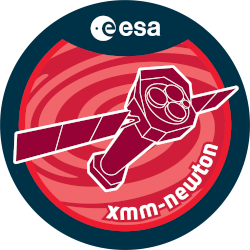

| Proposal ID | 067474 |
| Title | Do hybrid morphology radio sources form in a lopsided distribution of cold gas? |
| Download Data Associated to the proposal | https://nxsa.esac.esa.int/nxsa-sl/servlet/data-action-aio?obsno=0674740101 |
| DOI | https://doi.org/10.5270/esa-npqabch |
| Principal Investigator, PI | Dr Brendan Miller |
| Abstract | We test the hypothesis that hybrid morphology radio sources (HYMORS;Gopal-Krishna & Wiita 2000) feature one-sided jet disruption caused bypropagation into a large-scale overdensity of cold gas, through XMM-Newtonobservations of B2 1404+25A and B2 1345+28 (33 and 16 ks, respectively). TheseHYMORS are intrinsic low-inclination RLQs for which the X-ray spectra wouldordinarily be unabsorbed. VLBA mapping places the FRI jet on the near side in B21404+25A, and so the putative disrupting medium can be directly detected asabsorption against the core; in contrast, the FRII lobe is closer in B2 1345+28,and so a simple power-law X-ray spectrum is anticipated. Distinct results arepredicted for alternative scenarios of HYMORS formation. |
| Publications |
|
| Instrument | EMOS1, EMOS2, EPN, OM, RGS1, RGS2 |
| Temporal Coverage | 2011-12-13T15:35:12Z/2011-12-18T04:41:44Z |
| Version | 17.56_20190403_1200 |
| Mission Description | The European Space Agencys (ESA) X-ray Multi-Mirror Mission (XMM-Newton) was launched by an Ariane 504 on December 10th 1999. XMM-Newton is ESAs second cornerstone of the Horizon 2000 Science Programme. It carries 3 high throughput X-ray telescopes with an unprecedented effective area, and an optical monitor, the first flown on a X-ray observatory. The large collecting area and ability to make long uninterrupted exposures provide highly sensitive observations. Since Earths atmosphere blocks out all X-rays, only a telescope in space can detect and study celestial X-ray sources. The XMM-Newton mission is helping scientists to solve a number of cosmic mysteries, ranging from the enigmatic black holes to the origins of the Universe itself. Observing time on XMM-Newton is being made available to the scientific community, applying for observational periods on a competitive basis. |
| Creator Contact | https://www.cosmos.esa.int/web/xmm-newton/xmm-newton-helpdesk |
| Date Published | 2013-01-20T00:00:00Z |
| Last Update | 2025-08-04 |
| Keywords | "alternative scenarios", "low inclination rlqs", "fri jet", "vlba mapping", "XMM", "cold gas", "xray spectra", "b2 1345", "scale overdensity", "wiita 2000", "b2 1404", "cold gas ?.", "lopsided distribution", "xmm newton", "frii lobe", "gopal krishna", "XMM-Newton", "disrupting medium", "sided jet disruption", "hymors formation" |
| Publisher And Registrant | European Space Agency |
| Credit Guidelines | European Space Agency, Dr Brendan Miller, 2013, 'Do hybrid morphology radio sources form in a lopsided distribution of cold gas?', 17.56_20190403_1200, European Space Agency, https://doi.org/10.5270/esa-npqabch |